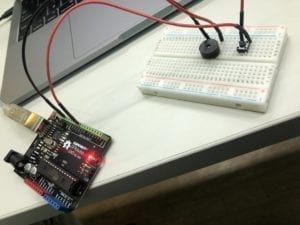Introduction
For this recitation, I had to build 3 basic circuits using the different components of Arduino.
Materials
- 1 * Breadboard
- 1 * LM7805 Voltage Regulator
- 1 * Buzzer
- 1 * Push-Button Switch
- 1 * Arcade Button
- 1 * 220 ohm Resistor
- 1 * 10K ohm Resistor
- 1 * 10K ohm Variable Resistor (Potentiometer)
- 1 * LED
- 1 * 100 nF (0.1uF) Capacitor
- 1 * 12 volt power supply
- 1 * Barrel Jack
- 1 * Multimeter
- Several Jumper Cables (Hook-up Wires)
Circuit 1: Doorbell
For this circuit I had to make a doorbell using a buzzer and a button so that when the button is pressed, the circuit is completed creating the buzzer sound.

Circuit 2: Lamp
In the second circuit, similar to the first, I had to create a “lamp” using an LED light. Creating this circuit only meant replacing the buzzer with an LED. The button was also there so that when it was pressed, the LED would turn on.

Circuit 3: Variable Lamp
For the third circuit, I attached a potentiometer and let Arduino read its values. I connected the LED to a PWM input which let it read analog signals, and by doing so, I was able to control the brightness of the LED using the potentiometer.

Questions:
1) Circuit interactivity
- In its most basic form, these circuits were interactive because of the use of the button and the potentiometer— I press a button and the light turns on, or I twist a knob which controls the brightness of the light.
2) Interaction in art
- Art itself is meant to grab people’s attention. Interactivity can be used as a very effective tool in attracting people towards the art. Art in the traditional sense is meant to be looked at, however, if the viewer were to be part of the art viewing experience, being able to change the art itself with their interaction, then people will be more likely to be interested in it. Using the Wooden Tile Mirror as an example, the viewer is able to project their physical form onto a mirror created with wooden tiles. This creates an abstract image of the viewer, changing the art viewing experience.